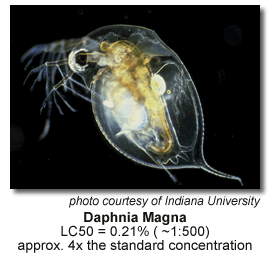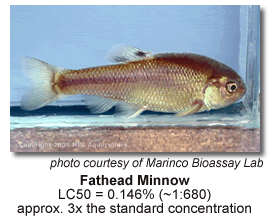Aquatic Toxicity Analysis

Waterborne Application
The phenomenon of the occasional "fish kill" is one that people involved in pond management are familiar with. There are many contributing factors that can trigger this event and often several of them need to occur simultaneously. Some of the most common are: low dissolved oxygen, high water temperatures, prolonged cloudy weather, excessive algae, and overcrowded populations.

Over the last 50 years of sealing lakes, ponds and lagoons, Seepage Control, Inc. has occasionally seen a fish kill after a waterborne treatment of ESS-13. Other times the aquatic environment has seemed to thrive. There has been speculation that the oily nature of the product causes a mechanical disruption to respiration in fish, however this idea has not been confirmed. Seepage Control, Inc. contacted the Marinco Bioassay Laboratory located in Sarasota, Florida to run tests to determine the toxicity of ESS-13 on the aquatic environment.
The lab ran standard toxicity tests on Fathead minnows (Pimephales promelas) and Daphnia (Daphnia magna) to determine LC50 values for the product (lethal concentration that causes 50% mortality in a test sample). The testing shows that the product is non-toxic and any effect on the organisms is at concentrations significantly higher than our standard treatment. While the occasional loss of fish is unfortunate, we are pleased to see the lack of toxicity of ESS-13 shown by these tests.

For more information, or to tell us about your project, please contact us today!
